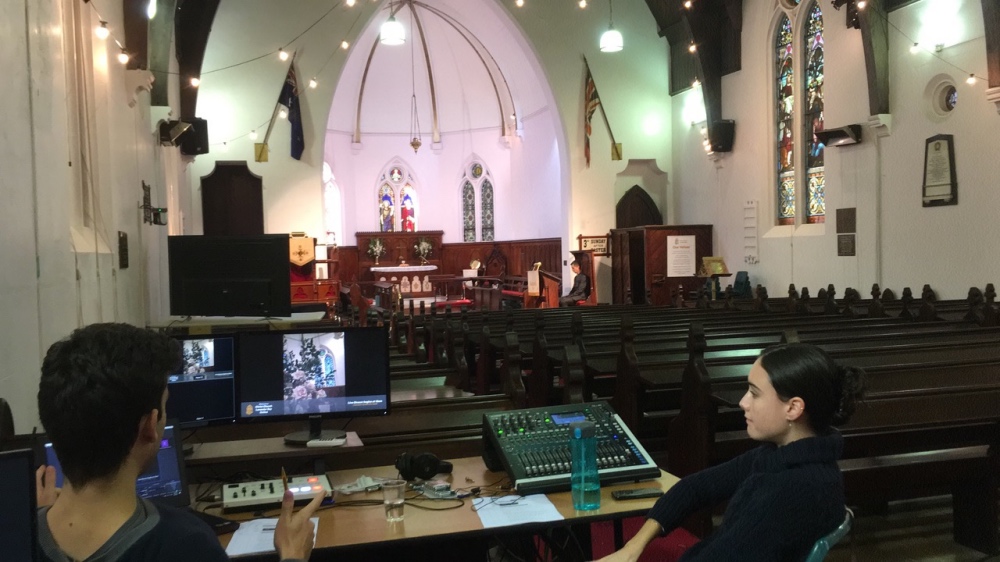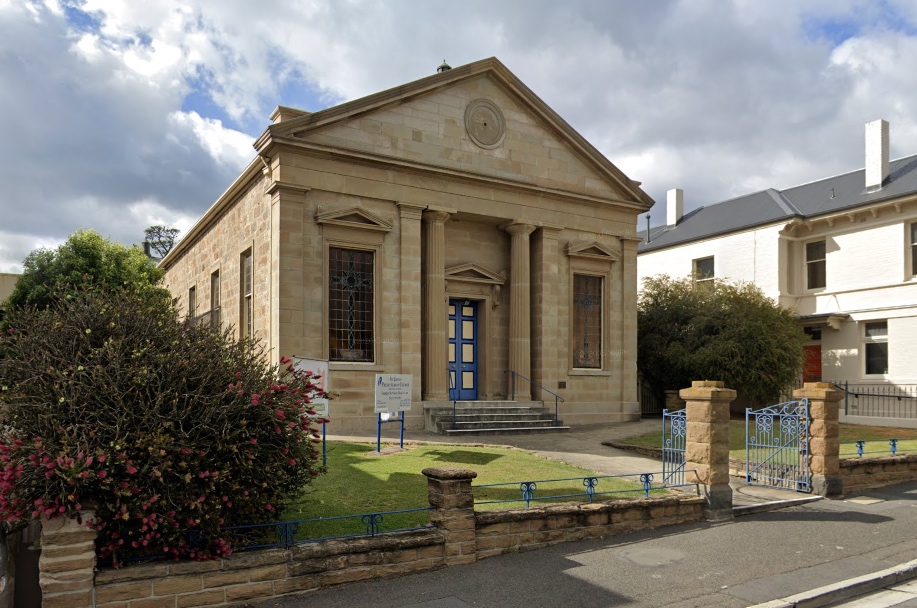
CHRISTOPHER GILBERT reports on how Australian churches are adapting as coronavirus restrictions start to ease…
Sydney, Australia
Jason Hoet, lead pastor of Unley Park Baptist Church in Adelaide, South Australia, was glad he was tech savvy thanks to his past employment in engineering. His medium-sized church of 300 was one of many Australian churches to run a virtual service on the first weekend of COVID-19 mandatory isolation.
“It was rough as anything but because it was novel for everybody, they cut us a lot of slack,” he says. “It was super-stressful in the first six weeks. Because of daily changes in the government plans. Our plans became irrelevant easily.”

The team at Christ Church, Lavender Bay, an Anglican church in Sydney, live-streaming a service. PICTURE: Christopher Gilbert
On or immediately after 23rd March, 2020, 85 per cent of Protestant Churches across Australia adopted some form of digital streaming of their worship services and other church events, according to a survey of 182 churches across Australia.
A joint project of church leadership training body, Partners in Ministry, and the Centre for Ministry Development at Moore College in Sydney, the survey, which was published two weeks after Easter, found that all of the churches said their online attendance is now significantly larger than their previous in-church appearances. One pastor reported to Sight there had been a more than 200 per cent increase in the number of people watching his church movement’s live-stream with those logging on coming from 60 some countries.
“The leaders of these churches have done a remarkable job. Because most of these churches were up and running with live-streaming by the first or second weekend of the COVID-19 restrictions.”
– Peter Mayrick, of Partners in Ministry.
“The leaders of these churches have done a remarkable job,” says Peter Mayrick, of Partners in Ministry. “Because most of these churches were up and running with live-streaming by the first or second weekend of the COVID-19 restrictions.”
And that includes churches with congregations of 100 or less people, not just the larger churches.
Church leaders Sight spoke with in five states say it has been an exhausting two months so far. But the learning curve has revealed remarkable opportunities for the church’s mission, revealed unfounded fears about online community and exposed pitfalls to avoid in both the online environment and the return to whatever “normal” the still unknown future allows.
Tim Hanna, former senior pastor of Gateway Baptist Church in Brisbane and recently retired CEO of Compassion now represents Partners in Ministry in Queensland. He summarised the experience of church leaders there.
“By the end of Easter they could exhale,” he says, “but by Mother’s Day they knew it was going to be a long haul.”
In a congregation which includes everyone from infants to the elderly, Jason Hoet’s ministry team at Unley Park Baptist in Adelaide had to figure out how to engage as many as possible online, learn to preach to a camera, and how to mix music and sing in a live-streamed environment. They settled on live-streaming as the most authentic real time experience of connecting – and because it didn’t require the extra task of editing.
“People have responded very positively to live-streaming,” he says.
Alistair Bain, senior minister at St John’s Presbyterian Church in Hobart, in the southern island state of Tasmania, took a week longer to get his church online. He too elected to live-stream services based on the authenticity of the medium as well as the way it can be used to promote a culture of care.
“There was a real risk that we’d drift apart from one another or, worse, that we’d drift away from Jesus,” Bain says. “So, we developed a buddy system after identifying 35 people for whom isolation could be difficult.”
He explains that older people and new mums were partnered with able-bodied volunteers who would phone them a couple of times in a week, and assist by running errands and praying with them.
“One of the blessings we found from that was that not everybody knew each other before.” Bain says. “It created an opportunity for new relationships and genuine care to occur.”
The Partners in Ministry/Moore College survey echoes this acceptance of internet worship and the innovation in care by congregations nationwide.

Peter Mayrick of Partners in Ministry. PICTURE: Supplied.
For the seven City on a Hill Churches, the COVID-19 restrictions forged a tight collaboration among core leaders in churches with a geographic spread which includes seven locations in the Victorian capital of Melbourne, the neighbouring city Geelong, and Victorian coastal community of Torquay as well as Queensland’s Gold Coast, and the Queensland capital of Brisbane.
City on a Hill had initially opted for a central streamed service.
“There was a strong response to the digital service but we soon noticed a longing for local content,” says Pastor Luke Nelson of the movement’s Melbourne West church. “So after a month, each of the sites has been trying to supplement the movement wide thing.”
While the pre-coronavirus restriction churches had boasted some 2,430 people, as many as 5,435 devices have more recently logged into its central service.
Peter Mayrick says that some churches which didn’t go online with services had made good use of older technology.
“There was a strong response to the digital service but we soon noticed a longing for local content. So after a month, each of the sites has been trying to supplement the movement wide thing.”
– Luke Nelson, pastor of City on a Hill’s Melbourne West church.
“Church leaders are saying it can be a refreshing thing to use a phone with their people,” he says. “Somehow turning off the screen can make for a better call. It’s not as intense as when you’re conscious of how you appear on screen. And one-to-one is better contact than one-to-many.”
Some churches have used both modern and older technologies.
While Mark Calder, the tech savvy Anglican Bishop of Bathurst, has been pre-recording a service for many of the smaller parishes in his large rural diocese, he’s also been making DVDs of services which are mailed out to older parishioners who are not internet savvy.
And Graham Humphris, who chairs the Uniting Church’s South Australian Generate Presbytery, reports that Generate member churches are also making DVDs for those without internet access.
Most churches, whether online or not, are reporting a lot more participation from their congregations than in pre-lockdown times.
Alistair Bain, of St John’s Presbyterian in Hobart, is glad he can entrust the online streaming to a team of tech skilled members so that he can focus on preaching, teaching and pastoral care.
As a trainer of church leaders, Peter Mayrick likes the idea of delegation.
“It’s refreshing to me to see an increased level of delegated care.”

St John’s Presbyterian Church in Hobart Tasmania. PICTURE: Courtesy of Google Maps.
There was growing pressure in New South Wales last week for the government to extend a relaxation of restrictions for pubs and restaurants to include churches with both the Catholic and Anglican archbishops in Sydney as well as the Australian Christian Lobby arguing for the move. By Friday, the government had relented so that at point of writing, churches in NSW can begin to meet in groups of up to 50 people from 1st June. Weddings and funerals are allowed the same freedom.
But the number 50 creates difficulties for most small churches, because, along with the permission to meet in person come a minimum of 18 safety requirements.
For example, there’s a need to remove all paper items, Bibles, prayer books, printed service sheets, and soft furnishings. There’s mandatory “deep” cleaning after every event, and special procedures for communion, the use of toilets, entries and exits and food handling as well as notices to be given about live-streaming and attendees to be registered each time they attend. Then there’s the seating arrangements to maintain social distancing and the awkwardness of people giving greetings from that safe distance. And that’s just for starters.
For medium-sized churches of a few hundred virtual services will likely remain the norm until restrictions are further eased. Those churches then have to decide if they can manage multiple in-person and streamed services. Mega churches are in the same category as major sporting events and services will remain on the internet until crowds are allowed to attend stadiums.
Pastor Louis Glazebrook, of City on a Hill, Surf Coast based in Torquay, captured the dilemma succintly.
“We can’t be waiting until October as if it’s all going to return to what it was. We have a new broken reality, and some of the things that I loved, they might not be coming back.”
Meanwhile discussions among church leaders continue.
“Now’s a time for reflection, to understand what has been good, what we’re grateful for, what to take forward, what to leave behind, and what is sustainable,” says Peter Mayrick, whose Partners in Ministry report has resulted in much thought and reflection among church leaders.
Others who have been promoting discussions include Rev Dominic Steele of The Village Church in Sydney who has been passing advice forward via his video blog site, The Pastor’s Heart. Craig Bailey, a leader in a recently planted Uniting Church in Mitcham Hills in South Australia, is among those who affirms that, as well as more time for individual contact with church members, the coronavirus shutdowns have also led to greater reflection on ministry.
Mostly discussions among pastors have been optimistic, especially given the increased numbers of people listening in to evangelical Gospel preaching. Churches using the online Alpha program for people who are interested in learning about Christianity report numbers as high as 15 times the usual enrolment. And they say their own people are more likely to talk with others about Jesus.
Hobart’s Rev Alistair Bain is wistful when he considers that what he says has been a highly productive and peaceful period of ministry might soon end. People, he says, are reporting having spiritual conversations with others in a manner they haven’t had in 20 years.
“Some people have expressed to me that when we get back together, and we’re chatting over tea and coffee, they’re afraid those spiritual conversations might dry up.”
Bain also notes how much his marriage and family life has flourished in the intimacy brought about by isolation.
“Some people have expressed to me that when we get back together, and we’re chatting over tea and coffee, they’re afraid those spiritual conversations might dry up.”
– Rev Alistair Bain, of St John’s Prebysterian Church, Hobart.
There continue to be, however, major obstacles to overcome in virtual environments.
Adelaide’s Jason Hoet as well as City on a Hill’s Luke Nelson and Louis Glazebrook all agree that for teens and young adults, the online medium just does not work. Ironically, the generation that seems to live through its devices does not want to meet via video chats: They want face-to-face togetherness (less suprisingly, perhaps, the pastors have also found that many people over 50 don’t like to use Zoom or have the computer skills to do so).
Hoet notices that when his own teenagers meet online they don’t have the camera turned on.
“They talk without screens, so I asked them ‘What’s the deal with that?’ and they said, ‘We don’t want to just have to sit around and wear the right clothes’. They’re not enjoying it,” he says.
With children, he notices that the girls fare much better when it comes to events delivered online than the boys.
“So, when you talk about ‘re-entry,’ youth, the elderly, and children are the three priority groups that we are trying to address first,” says Hoet. “The online format just does not suit them.”
Asked about planning for the future, church leaders who spoke with Sight, gave mixed responses.
Tim Hanna in Queensland reckons many pastors are “gun shy” on planning because of the constant changing of the playing field by the state and federal governments. Alistair Bain in Tasmania says he came away from an online Reach Australia conference in the past week wondering how it was possible to plan for a future that remains “fuzzy.”
He’s satisfied that his current live-streaming is working well, whatever it might lack in slickness.
“I don’t want to make it too good or they won’t come back,” he says.
City on a Hill pastors Nelson and Glazebrook agree with the sentiment. They are concerned that live-streaming could allow for a consumer mindset to develop in which people continue to observe church passively without attending in person as well as how to bring in the people who were on the margins of the church pre-lockdown or who have been attending online services but didn’t previously do so in person.
Nelson, meanwhile, is also worried about how people might come out of such an extended period of isolation.
“It’s called the third quarter syndrome. As people anticipate the end of their isolation they become anxious and irritable and it affects their behaviour,” he says. “So I expect the next months might be trickier for us.”





